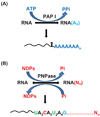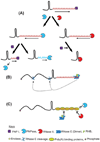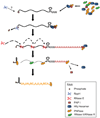Bacterial/archaeal/organellar polyadenylation
- PMID: 21344039
- PMCID: PMC3041983
- DOI: 10.1002/wrna.51
Bacterial/archaeal/organellar polyadenylation
Abstract
Although the first poly(A) polymerase (PAP) was discovered in Escherichia coli in 1962, the study of polyadenylation in bacteria was largely ignored for the next 30 years. However, with the identification of the structural gene for E. coli PAP I in 1992, it became possible to analyze polyadenylation using both biochemical and genetic approaches. Subsequently, it has been shown that polyadenylation plays a multifunctional role in prokaryotic RNA metabolism. Although the bulk of our current understanding of prokaryotic polyadenylation comes from studies on E. coli, recent limited experiments with Cyanobacteria, organelles, and Archaea have widened our view on the diversity, complexity, and universality of the polyadenylation process. For example, the identification of polynucleotide phosphorylase (PNPase), a reversible phosphorolytic enzyme that is highly conserved in bacteria, as an additional PAP in E. coli caught everyone by surprise. In fact, PNPase has now been shown to be the source of post-transcriptional RNA modifications in a wide range of cells of prokaryotic origin including those that lack a eubacterial PAP homolog. Accordingly, the past few years have witnessed increased interest in the mechanism and role of post-transcriptional modifications in all species of prokaryotic origin. However, the fact that many of the poly(A) tails are very short and unstable as well as the presence of polynucleotide tails has posed significant technical challenges to the scientific community trying to unravel the mystery of polyadenylation in prokaryotes. This review discusses the current state of knowledge regarding polyadenylation and its functions in bacteria, organelles, and Archaea.
Keywords: Hfq; RNA degradation; poly(A) polymerase; polynucleotide phosphorylase.
Figures






Similar articles
-
The Sm-like protein Hfq regulates polyadenylation dependent mRNA decay in Escherichia coli.Mol Microbiol. 2004 Nov;54(4):905-20. doi: 10.1111/j.1365-2958.2004.04337.x. Mol Microbiol. 2004. PMID: 15522076
-
Exonucleases and endonucleases involved in polyadenylation-assisted RNA decay.Wiley Interdiscip Rev RNA. 2011 Jan-Feb;2(1):106-23. doi: 10.1002/wrna.45. Epub 2010 Sep 15. Wiley Interdiscip Rev RNA. 2011. PMID: 21956972 Review.
-
Polynucleotide phosphorylase and the archaeal exosome as poly(A)-polymerases.Biochim Biophys Acta. 2008 Apr;1779(4):247-55. doi: 10.1016/j.bbagrm.2007.12.004. Epub 2007 Dec 15. Biochim Biophys Acta. 2008. PMID: 18177749 Review.
-
Polyadenylation in bacteria and organelles.Methods Mol Biol. 2014;1125:211-27. doi: 10.1007/978-1-62703-971-0_18. Methods Mol Biol. 2014. PMID: 24590792
-
The response regulator SprE (RssB) modulates polyadenylation and mRNA stability in Escherichia coli.J Bacteriol. 2009 Nov;191(22):6812-21. doi: 10.1128/JB.00870-09. Epub 2009 Sep 18. J Bacteriol. 2009. PMID: 19767441 Free PMC article.
Cited by
-
Targeted insertion of large genetic payloads using cas directed LINE-1 reverse transcriptase.Sci Rep. 2021 Dec 8;11(1):23625. doi: 10.1038/s41598-021-03130-0. Sci Rep. 2021. PMID: 34880381 Free PMC article.
-
RNase E forms a complex with polynucleotide phosphorylase in cyanobacteria via a cyanobacterial-specific nonapeptide in the noncatalytic region.RNA. 2014 Apr;20(4):568-79. doi: 10.1261/rna.043513.113. Epub 2014 Feb 21. RNA. 2014. PMID: 24563514 Free PMC article.
-
Bacterial transcriptomics: what is beyond the RNA horiz-ome?Nat Rev Microbiol. 2011 Aug 12;9(9):658-69. doi: 10.1038/nrmicro2620. Nat Rev Microbiol. 2011. PMID: 21836626 Review.
-
Enzymes Involved in Posttranscriptional RNA Metabolism in Gram-Negative Bacteria.Microbiol Spectr. 2018 Apr;6(2):10.1128/microbiolspec.rwr-0011-2017. doi: 10.1128/microbiolspec.RWR-0011-2017. Microbiol Spectr. 2018. PMID: 29676246 Free PMC article. Review.
-
Ribonucleoprotein particles of bacterial small non-coding RNA IsrA (IS61 or McaS) and its interaction with RNA polymerase core may link transcription to mRNA fate.Nucleic Acids Res. 2016 Apr 7;44(6):2577-92. doi: 10.1093/nar/gkv1302. Epub 2015 Nov 24. Nucleic Acids Res. 2016. PMID: 26609136 Free PMC article.
References
-
- August J, Ortiz PJ, Hurwitz J. Ribonucleic acid-dependent ribonucleotide incorporation. I. Purification and properties of the enzyme. J Biol Chem. 1962;237:3786–3793. - PubMed
-
- Hardy SJ, Kurland CG. The polynucleotide product of poly(A) polymerase from Escherichia coli. Biochemistry. 1966;5:3668–3676. - PubMed
-
- Edmonds M, Abrams R. Polynucleotide biosynthesis: Formation of a sequence of adenylate units from adenosine triphosphate by an enzyme from thymus nuclei. J Biol Chem. 1960;235:1142–1148. - PubMed
-
- Edmonds M, Abrams R. Nature of a polynucleotide required for polyribonucleotide formation from adenosine triphosphate with an enzyme from thymus nuclei. J Biol Chem. 1962;237:2636–2642. - PubMed
-
- Nakazato H, Venkatesan S, Edmonds M. Polyadenylic acid sequences in E. coli messenger RNA. Nature. 1975;256:144–146. - PubMed
Publication types
MeSH terms
Grants and funding
LinkOut - more resources
Full Text Sources
Other Literature Sources
Research Materials
Miscellaneous

